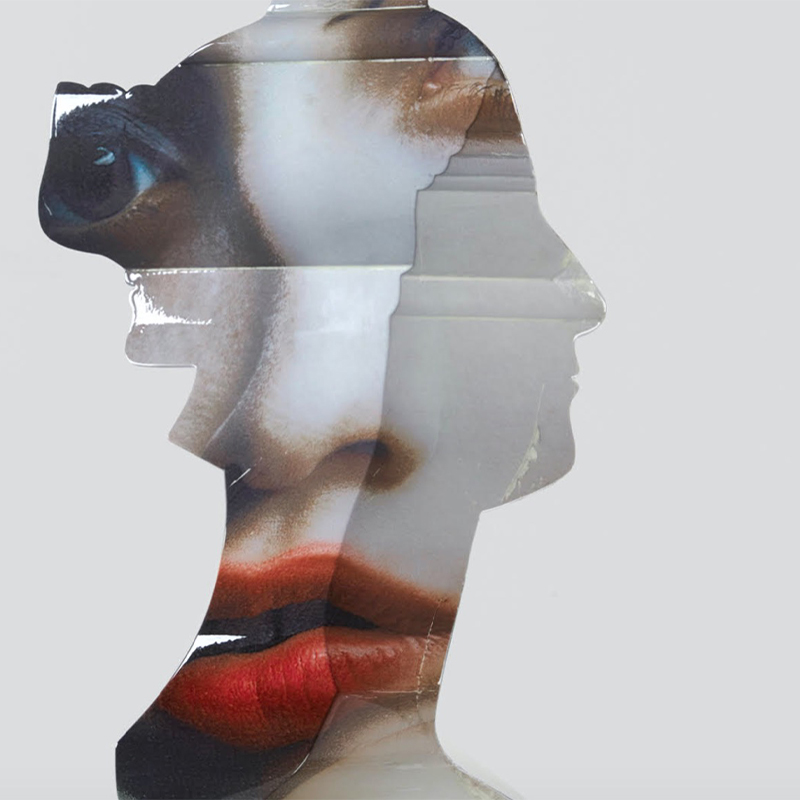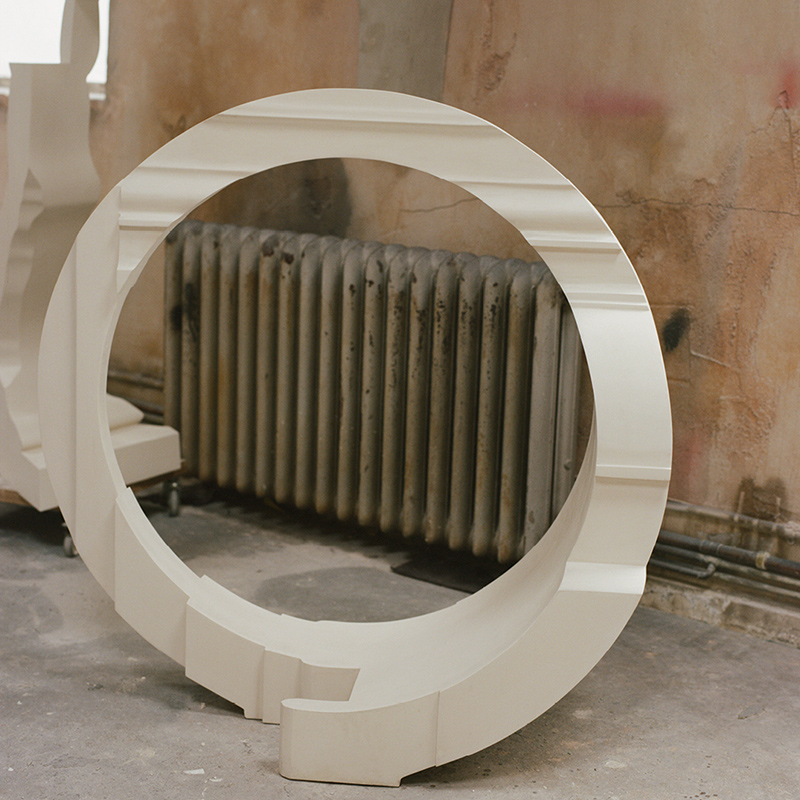“Images… can be explosive”: Vogue artist-in-residence Nick Hornby sculpts a new perspective
4 MAY 2021
Nick Hornby, a British artist who uses digital technology to create his dynamic sculptures, has always been fascinated by how art and history intersect. Recently, he's also gained a fresh appreciation for intimacy and collaboration. He sat down with Vogue Singapore to talk about his inspiration and process, and how they've changed in the last year.
Nick Hornby’s sculpture, created just for Vogue Singapore, started life as a picture of the model Jazzelle Zanaughtti, taken by photographer Louie Banks. Together, the team “liquified” the image. Hornby took a sculpture he’d carved out of marble, a bust silhouette that transforms itself as you walk around it and take it in from different angles, and “dipped” it into this image. The resultant work of art is something entirely different, something that wouldn’t have materialised at the end without each step—and collaborator—in the process.
Hornby has exhibited all over the world, in the United Kingdom, the United States, Switzerland, Greece, and India. He’s known primarily as a sculptor who works with marble, resin, and bronze—and incorporates computer programmes into his process. He channels ideas that come from the history of art into his work. It’s only recently that he’s delved into his own personal history for inspiration, plumbing the depths of his autobiography for inspiration. The photo-sculptures he’s created this year have been a direct product of that, whether they be abstract shapes or mantelpiece busts.
In his Notting Hill studio in London, which is a breeze-block warehouse that has the quiet, reverent air of a church, he worked with a team to create an image from an idea, and an object from an image. His is a breathless, whirlwind artistic process. Here, he pauses for just a moment or two to speak with Vogue Singapore about history, the pandemic, and the power of opening yourself up to multiple viewpoints.

How did you go about making this sculpture for Vogue Singapore?
The theme of the issue is “Perspective,” which is an idea I think about a lot. The “invention” of perspective in the Renaissance is often taken to be the most prominent moment in the last 2000 years of visual culture. But more recently we’ve seen the crumbling of single point perspective, and the merits of that collapse: from cubism to the radical 60s which fought against dominant myopic structures of chauvinism, homophobia, xenophobia. We now celebrate pluralism and multiple perspectives, recognising the hegemony inherent in the idea of single-point perspective, and its potential to marginalise anything outside the dominant view of those with power.
In 2020, I started working with a process of liquified photography and sculpture, which has felt like a real breakthrough in my practice. The images included some high-fashion images, so when Vogue Singapore approached me it seemed like an ideal opportunity to return these images back to the page of a magazine. In many ways reproducing images of my work in the magazine is a reversal of my process: rather than overlaying a photo onto a sculpture, the sculpture might appear to carve out the image from the page. I thought this playful inversion could be fascinating and poetic.
What inspired you? You mentioned that the idea of a drawn-in eyebrow compelled you—why?
The drawn in eyebrow was important. It speaks simultaneously about gender identity as a construct and mark-making in painting. These two issues seem so vast, so loaded, and yet they play out gently over the disarming surface of this beautiful model’s face. The model, Jazzelle Zanaughtti, is amazing. i-D magazine described her as a “gender-bending, gold-grilled model slaying on Instagram” with a “sass-filled Detroit voice,” and who “sits right in the centre of fashion’s rising representations of racial diversity and queer gender expression.” Which is everything I want for this work.
How do the elements of the “light” image and the “heavy” sculpture come together in your work?
I hope they coalesce, in ways that are momentary too, so that time is another ingredient in the encounter. These works are the product of so many components—complex processes, voices, references, all under the hermetic seal of a glossy surface. I’m interested in trying to make an object that feels coherent and believable, an object that you can find and recognise in everyday life. But this momentary normalcy gives way to something more strange and uncanny. The image overpowers the object, or the object overpowers the image, and at that point interpretation and the viewer kicks in. It’s very exciting to work with images. I’m not sure I believe that they are “lighter” than objects. But I do think they can be explosive.

So you made the sculpture by “dipping” it into the photograph. Can you explain that a little more?
It is a mixture of marbling and wet photography. It’s a rather magical process to witness. We place the image on the surface of water, and gently peel the “paper” away, leaving only the ink suspended. For a brief moment the picture remains intact, before we slowly submerge the sculpture through the surface of the water and the ink adheres to the object as they meet. The image is momentarily liquid which makes for a very exciting, very tense process with a “reveal” like the appearance of the photographic image in a dark room.
What do you consider to be “post-digital” art?
“Post-digital” sounds complicated, but it’s simply where the digital is mainstream rather than futuristic. It is “post” because “the digital” is no longer an alternative—it is the norm. We don’t “go online” because we are always online. Our digital lives are simply “our lives.” My work adopts a similar position—seamlessly mixing digital and analogue, blurring those boundaries. I have quite an ahistorical approach to life. I find as much relevance in the past as I do in the front pages of today’s newspaper. This sculpture owes a debt to Victorian marble busts, but has a feeling of glossy screen technology too.
What kind of impact has the pandemic had on your work?
It has had a very profound impact.The pandemic caused a dramatic break in the chain of back-to-back exhibitions. Previously, each series and each exhibition felt like a cliff-hanger, leading without hesitation to the next work and the next show. Lockdown forced a sabbatical and the result was a huge shift. For a long time my practice explored historical themes. Last year, something clicked and I realised I had my own story to tell: my work has become autobiographical and personal.

Speaking of autobiography, how did you get into sculpture?
How I got there I’m not sure. Biology, ethnography, what role those all played isn’t something I can really know. But at 14, I started modelling figures in terracotta. I abandoned that in my 20s in favour of new media art—film, video and performance—only to return to it in my 30s. My early experiments modelling clay and the figure still inform my work today.
What aspects of your identity most profoundly inform your work?
Until this year, I kept my identity out of my practice. In fact I used systems of digital calculation and manufacture partly in an effort to eliminate my subjectivity. Automation and algorithms felt important, like 3D printing and Amazon recommendations. I found it fascinating to have a practice where I could almost judge my work as if it was someone else’s.
Something shifted this year during the pandemic—I craved intimacy. I started to make work that was very personal. For this work for Vogue Singapore, I was fascinated by the space of a fashion magazine as a site for these hybrid objects; the act of returning Louie Banks’ image back to the glossy page. In some ways I couldn’t imagine a more perfect endgame for this sculpture.
How was Louie Banks as a collaborator?
Louie is incredible. He photographs mega-celebrities as well as friends from the queer scene. He treats both with equal intimacy and he empowers his subjects from subcultures whose voices are otherwise marginalised. I invited Louie over to the studio and we spent an afternoon chatting, and hands-on experimenting. It was a great exchange, with fast dialogue and clear potential for something exciting. His eye is tuned very differently from mine, which I find fascinating and exciting.

The sculptor is sometimes thought of as this “lone artist” figure. Do you feel like that stereotype suits you?
I would say a painter probably fulfills the “lone artist” archetype better. Sculpture has always been a collaborative process. Moving large pieces of marble, casting clay into bronze, engineering large public works—none of that can be done by one person alone, so to some extent collaboration is built-in to sculpture. I take this one step further by actually co-authoring work with other artists. And, yes, I learn a lot about myself, my assumptions, my creative process. I find collaborations enormously rewarding: the dialogue with the other artist, relinquishing a little control and breaking away from personal habits.
You have to relinquish control if you want to allow an audience to experience your art. Has someone ever engaged with your work in a way that particularly stuck with you?
Every single person who engages with my work intrigues me. It is never expected and always exciting. The notion of interpretation is at the core of my practice: how meaning is fashioned and the different perspectives different sets of eyes will bring. I work in multiple types of spaces, from the gallery to the public realm, and so my work encounters a huge variety of audiences. Some are art specialists who come to my work with a host of references and prior knowledge, others less so, but I’m interested in what people make of the work, what it means to them and where that interpretation comes from.

So this piece was a breakaway from the idea of art history you’ve explored in the past. But did you feel like you were creating it in a vaccuum, because of that? Did you feel the weight of history in making it?
How funny you should ask this. Yes, I feel the history of sculpture very much. I would go as far as to say I think in terms of a vocabulary of sculptures. But that vocabulary is drawn from my own encounter with art, which has its inevitable geographic and historical biases. I hope it is self-aware in its historicism, and increasingly pluralistic too.
Aside from visual art, there is also the index of other objects, like cars, iPhones, vases, trees, satellites, nuclear reactors. And there are other humans. The way you relate to the form of sculpture is based on how you understand all the other orbiting objects. They echo and ricochet in every other object: like the way we shake hands, hold door knobs, touch screens, feel the interior of shoes, look out from a balcony, or shelter under a tree. The object is always animated by our encounter with it, our experience of it.
Video credits
Editor-in-Chief: Norman Tan
Director & DOP: Benjamin Mallek
Music: Oliver Lukitsch
